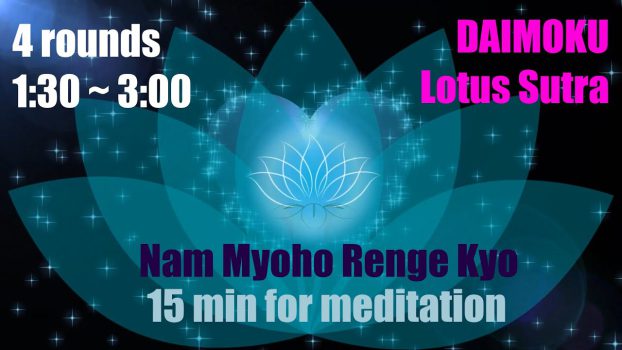Wim Hof Breathing Technique [4 rounds with 30 breaths each] INSTRUCTIONS:
1) Take a deep breath in and let the air out! Inhale fully from stomach to chest to head through the nose or mouth, then let the exhale happen naturally through the mouth. Fill your lungs deeper than you thought possible and then relax, letting the air out. Repeat this for 30 times.
2) Then let the air out and hold for as long as you can without force. Hold the breath.
3) Inhale to full capacity. Feel your chest expanding. When you are at full capacity, hold the breath.
4) Holding your breath, squeeze your belly, neck and then the head.
5) Let the air out naturally and then relax.
6) Repeat this process for 4 times!
7) Enjoy & have fun!
You may feel tingling in the hands, feet, or face. If the sensation of light-headedness gets too intense, just pause until you feel settled and then continue. Listen to your body and go with the flow.
#NamMyohoRengeKyo #Daimoku #LotusSutra
Breathing Technique Guided – 4 rounds with Nam Myoho Renge Kyo Chanting – Daimoku [Lotus Sutra]
[00:00] round 1) 30 breaths + holding your breath for 1 minute and 30 seconds
[03:42] round 2) 30 breaths + holding your breath for 2 minutes
[07:45] round 3) 30 breaths + holding your breath for 2 minutes and 30 seconds
[12:20] round 4) 30 breaths + holding your breath for 3 minutes
[17:20] +15 minutes for meditation with Nam-myoho-renge-kyo chant
[32:23] Subscribe, like & share! 🙂
Namu Myōhō Renge Kyō (南無妙法蓮華經; sometimes truncated phonetically as Nam Myōhō Renge Kyō) are words chanted within all forms of Nichiren Buddhism.
Lyrics translation:
Devotion to the Mystic Law of the Lotus Sutra /
Glory to the Dharma of the Lotus Sutra
The words Myōhō Renge Kyō refer to the Japanese title of the Lotus Sūtra. The mantra is referred to as Daimoku (題目) or, in honorific form, O-daimoku (お題目) meaning title and was first publicly declared by the Japanese Buddhist priest Nichiren on 28 April 1253 atop Mount Kiyosumi, now memorialized by Seichō-ji temple in Kamogawa, Chiba prefecture, Japan.
The practice of prolonged chanting is referred to as Shōdai (唱題) while mainstream believers claim that the purpose of chanting is to reduce suffering by eradicating negative karma along with reducing karmic punishments both from previous and present lifetimes, with the goal of attaining perfect and complete awakening.
Nichiren, whose teachings the Soka Gakkai is based on, awakened to the universal law of existence, and named it “Nam-myoho-renge-kyo.” Through the Buddhist practice he developed, he provided a way for all people to activate it within their own lives and experience the joy that comes from being able to liberate oneself from suffering at the most fundamental level and deal with challenges in life. Myo can be translated as mystic or wonderful, and ho means law. Renge, meaning lotus blossom, is a metaphor that offers further insight into the qualities of this Mystic Law.
Kyo literally means sutra and here indicates the Mystic Law likened to a lotus flower, the fundamental law that permeates life and the universe, the eternal truth.
This Mantra describes the essence of Buddhism – the conviction that we have within us at each moment the ability to overcome any problem or difficulty that we may encounter in life; a capacity to transform any suffering.
IMPORTANT: Do this breathing technique in a comfortable seat—either in a chair or on cushions on the floor. Do not do this practice before or during diving, driving, swimming, taking a bath or any other environment/place where it might be dangerous to faint!
Notice of Non-Affiliation and Disclaimer:
MEDIT-O-RAMA is not affiliated, associated, authorized, endorsed by, or in any way officially connected with the Wim Hof, The Wim Hof Method, Innerfire BV, or any of its subsidiaries or its affiliates.

Add comment